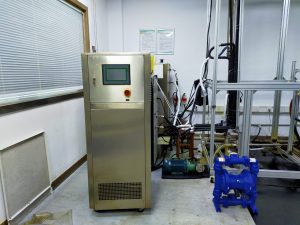Solution to the failure of the refrigeration and heating system of the reactor
When selecting the pipe material for the reactor refrigeration and heating system, you must pay attention to the connection of the pipe, the choice of the pipe and the material of the pipe. Because the pipe involves cooling and heating, you must remember to pay attention when choosing Oh!
When selecting thermal insulation materials, the temperature range of the refrigeration and heating system of the reactor should be considered first, and flame-retardant materials must be selected. The suitable temperature range of thermal insulation materials should include the temperature range of this equipment. In addition, the thermal insulation material package of the refrigeration and heating system of the reactor should be sufficient, otherwise the equipment control will not achieve the expected effect.
When connecting the refrigeration and heating system of the reactor to the controlled equipment, pay attention to the connection of the pipeline and avoid the error of the interface. Generally, the liquid outlet corresponds to the liquid inlet, and the liquid inlet is connected to the liquid outlet. If it is a water-cooled device , The water outlet corresponds to the water return port, the water inlet corresponds to the water outlet, and the liquid discharge port (used when changing the heat transfer medium) corresponds to the waste liquid recovery collection port.
When selecting pipelines, if improper/damaged hoses and/or hose joints are used, it will cause injury to personnel. Please refer to it carefully when the reactor refrigeration and heating system is equipped with metal insulation hoses and other pipelines. Its pressure-bearing and over-pressure capacity, caliber and suitable temperature range. At this time, the head pressure of the circulating pump inside the equipment needs to be considered. It is recommended that the refrigeration and heating system of the reactor should choose seamless steel pipes and other pipelines with good quality and sufficient caliber as much as possible.
The pipeline connection between the refrigeration and heating system of the reactor and the controlled object should be as short as possible to reduce bending. When the pressure of the circulation pipeline is too high and the pressure of the pipeline is insufficient, it will cause the pipeline and the reactor to burst and high temperature. , The possibility of low-temperature heat transfer medium spraying may cause personnel injuries, burns, frostbite and ignition of combustibles, etc.; pollution, property losses, and even personnel poisoning caused by the loss of reactants.
The vacuum phenomenon of equipment in the refrigeration and heating system of the reactor is one of the main reasons for the excessive noise of the hydraulic pump. When the oil is mixed with air, cavitation is easy to form in its high-pressure area and spread in the form of pressure waves, causing the oil to oscillate and causing the system to produce cavitation noise. The main reasons are: the oil filter of the hydraulic pump, the oil inlet pipe is blocked or the oil viscosity is too high, which can cause the vacuum at the oil inlet of the pump to be too high, causing air to infiltrate. The oil seal on the shaft end of the hydraulic pump and the pilot pump is damaged, or the oil inlet pipe is not well sealed, causing air to enter. The oil level in the oil tank is too low, so that the oil inlet pipe of the hydraulic pump is directly emptied.
When high noise occurs during the operation of the hydraulic pump, the above-mentioned parts should be inspected, and the problem should be dealt with in time. The internal components of the refrigeration and heating system of the reactor are excessively worn, such as the wear and tear of the piston pump cylinder body and the valve plate, the plunger and the plunger hole, etc., which cause serious leakage in the hydraulic pump. When the hydraulic pump outputs high pressure, When the flow rate of oil is small, flow pulsation will be generated, which will cause higher noise.
The hydraulic pump valve plate is also one of the important components that easily cause noise. When the reactor refrigeration and heating system equipment is in use, due to surface wear or sludge deposits on the opening of the unloading tank, the unloading tank will be shortened and the unloading position will be changed, resulting in oil trapping and higher noise.
If the reactor refrigeration and heating system equipment has a noise failure, it needs to be resolved in time, which can reduce equipment failures and improve production efficiency and effectiveness. For other usage content of the equipment, please contact our LNEYA technical engineer to obtain sales@lneya.com
Related recommendations
-
-
How to control the emulsification temperature of the emulsifier?
1531A good cream product is not only reflected in the quality of raw materials, but also has a great influence on the emulsification process during production, such as the texture and stability of the product, and the temperature control during produc...
View details -
Refrigeration Principle Of Low Temperature Chiller
1369The refrigeration principle of the so-called low temperature chiller is to use the artificial method, compressor refrigeration, through energy consumption, in a cycle process, in the process that cooling materials take away the heat. Generally spe...
View details -
Semiconductor production process and testing process temperature control unit
1434LNEYA semiconductor testing process chiller
View details
 LNEYA Industrial Chillers Manufacturer Supplier
LNEYA Industrial Chillers Manufacturer Supplier











